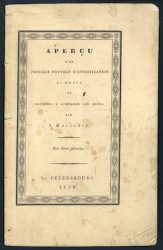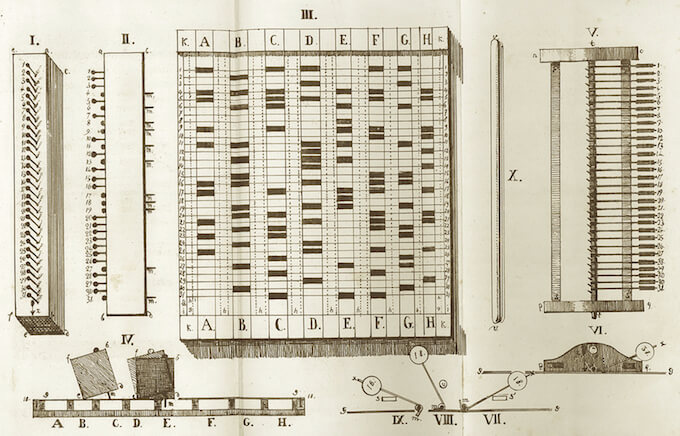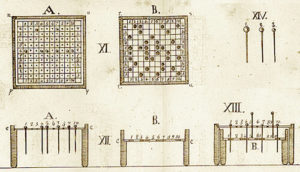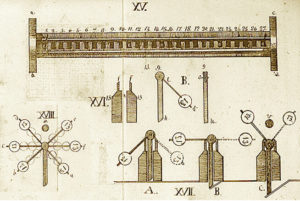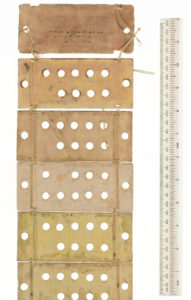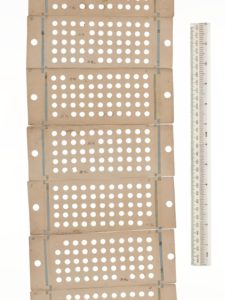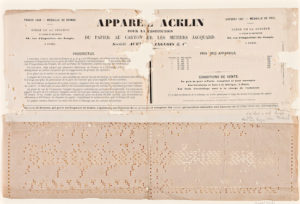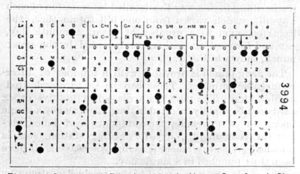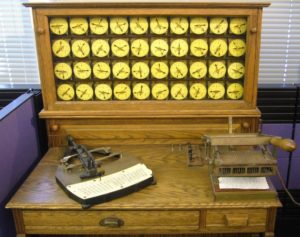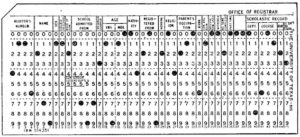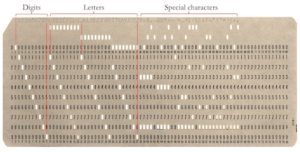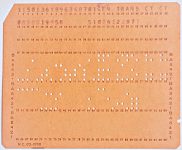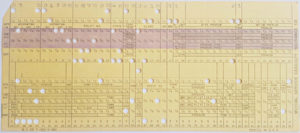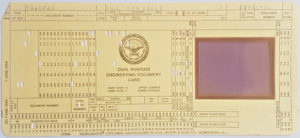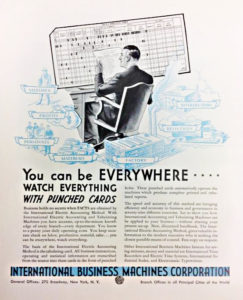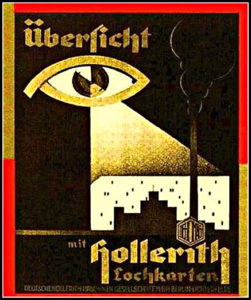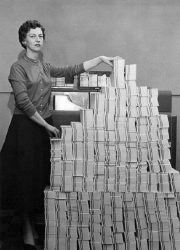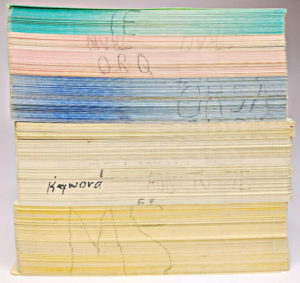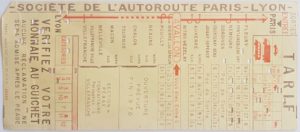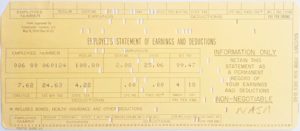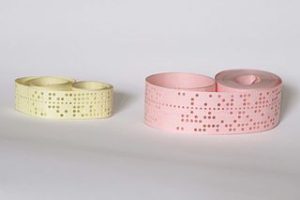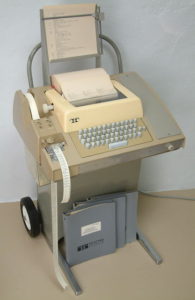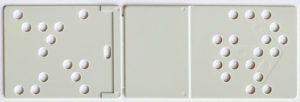Punched cards and tape: from Korsakov, Babbage, Hollerith to IBM and Computers.
Vladimir Esaulov. June 2020.
Today computers use magnetic, optical and solid state memory devices to store programs and data. From the dawn of digital computers, following World War II and up to the 1970s, data and program input and output was frequently performed using perforated (punched) tape or cards. The origin of this medium of data storage goes back to the 18th century efforts in France to automate the textile loom. Basile Bouchon, introduced punched tapes (1725), and Jean-Baptiste Falcon, improved with punched cards (1728-), for selecting and implementing textile patterns. This culminated, in the first years of the 19th century, in the appearance of the Joseph-Marie Jacquard loom (1804-): a combination of the Falcon loom with Jacques Vaucanson’s mechanised version (1745). The introduction of punched cards as a means of industrial process control, soon inspired others to extend its use to selection of data (or “ideas”) and more generally, in what we refer to as programming.
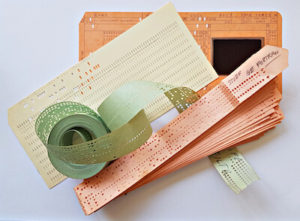
In 1832, the Russian Semyon Korsakov (1787-1853), a statistician and also a homeopath, proposed machines for comparing ideas, devices to select between e.g. various symptoms of diseases using a table on paper with a matrix of holes. The British scholar Charles Babbage (1791-1871), pioneered the idea of using punched cards for a computing device, while designing his Analytical Engine in the 1830-70s. The first actual use of punched cards was made in the USA by Herman Hollerith (1860-1929), who was trying to automate population statistics for the American census. His work and the company he established, which evolved into IBM, is at the origin of the massive use of this media in computer programming and computation as well as data handling in many domains. In this page we briefly describe the history of punched tapes and cards in information technology, how it all happened, how some ideas perished and others flourished. At the end, we show a spectacular 21st century nanotechnology “multipede” punched card. Some useful references are provided. The reader may find more historical information on certain aspects in the texts of Baehne (1935), Casey (1958), Heide (2009), Randell (1982) and others.
Semen Korsakov and the first attempt at information processing.
Korsakov was a statistician with the Russian Police Ministry in St. Petersburg, who, although not a trained doctor, started exercising medicine and shifted to homeopathy. He is generally well known for the development of his own homeopathic approach. Korsakov was actually interested in augmenting the possibilities of the human mind and in this respect his work discussed here, is relevant in the field of artificial intelligence. In the 1812-1814 period, he participated in the Napoleonic wars and visited Paris, where he may have seen a Jacquard loom.
In 1832 he described several machines for comparing ideas in his booklet written in French: Apercu d’un procédé nouveau d’investigation au moyen de machines a comparer les idées (Description of a new way of doing research, using machines for comparing ideas). Korsakov’s method was a punched card implementation of multi-criteria search of a large amount of data, incorporating weighting factors i.e. taking into account the relative importance of various criteria and is in this way a forerunner of modern expert systems.
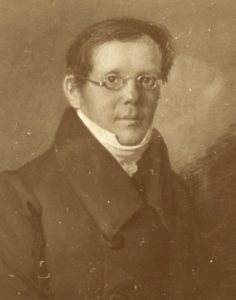
Korsakov presented (Korsakov 1832) his work to the Imperial Academy of Sciences in St. Petersburg, but unfortunately the expert commission headed by the mathematician M.Ostrogradskii refused to support it, failing to see the utility of mechanized searches of large amount of information. Korsakov’s machines anticipated by two decades the logic machine of Alfred Smee, whose The Process of Thought Adapted to Words and Language was published in 1851: a mechanical logical machine operating analogously to the human mind. Korsakov’s work in this area and from the point of view of mechanographic data processing has remained obscure until 1961, when the archives of the Academy of Science were published. A few years later his work was “discovered” by professor G.N.Povarov of the Moscow Engineering Physics Institute-MIFI (Povarov 2001, Shilov and Silantiev 2016).
Korsakov proposed five variations of a basic data selection and comparison concept for use in establishing a diagnostic and treatment of diseases. He really spoke in more general terms of “complex ideas”. These are, as shown inn the figures 3 and 4 adapted from his booklet, the:
- linear homeoscope with fixed parts;
- linear homeoscope with movable parts;
- flat homeoscope;
- ideascope;
- simple comparator.
The objective was to be able to rapidly find which “complex idea” or medicine best corresponded to a set of symptoms.
Korsakov’s punched card tables. Briefly, Korsakov proposed the use of a board covered with paper containing a table of “complex ideas” as he called it. Briefly: each “idea” or as in his example, medicine, was attributed one of the columns A,B…H in Table III (figure 3). The rows in the table, corresponded to symptoms (k) of illnesses numbered in the index columns kk’ on the left and right. Thus under each column heading, if a given medicine (A,B…H) could be given in the case of the presence of one of those symptoms, then the corresponding position of the table (say A(1), or A(4), etc)) was perforated. Alternatively in the case of the flat homeoscope the columns could correspond to body parts and the table thus represented what he called a Pathography of the body: a body part-symptom map for a given medicine. Similar tables could be made for different medicines.
The idea selectors. The selection was performed by a one or two dimensional device: either a selecting rod: the linear homeoscope of the length of a column (devices 1 & 2), or else a board of the same size as the table (flat homeoscope).
The linear homeoscope. The rod (I,II) was equipped with pins at each of the index positions k, much as in the textile loom. The pins were pushed through the selecting rod, protruding on the other side, at the positions of sought symptoms. The rod was then moved across the table column by column (IV). If all the protruding needles matched the holes on the table, the board would settle down and “stop” (IV at column E), thus indicating a match of all sought symptoms.
Movable homeoscope and weighting factors. As an alternative to this, the homeoscope with movable parts (V-X) had L shaped rods equipped with labels (VII-IX), that could rotate around an axis at the lower L bend (m). Symptom preselection involved placing the required rods in the almost vertical position (VIII). In sliding across the board from left to right, the rod would rotate left if there was a hole (IX), indicating a match with a symptom. As an interesting extension in this case, Korsakov suggested to use a label that could be positioned at different points along the rods (and use colours) (see IX), in order to indicate the importance of the symptom. This was a first use of weighting factors.
Flat homeoscope and “massively parallel” comparisons. In this case two superposable boards (XI) with the same tables (A,B) were used. In the lower board (B), holes were perforated in the paper at appropriate positions corresponding to a given medicine. In the upper board long pins were placed at positions corresponding to symptoms for the treated person (XII). If a hole was present under a pin, when the boards were superposed the pin would pass through and not stick out. Thus an instant view of all matches was obtained. A weighing factor was introduced by putting pins with different head sizes (XIV). Korsakov envisaged instant comparison of data in sets of hundred thousand, using a 100×100 table.
The ideascope and comparator. The ideascope (XV-XVIII) is an extension of the concept of the movable homeoscope, for use in comparing the degree of coincidence of ideas. In this case the perforated reference table did not have through holes but wedge shaped apertures with different depths/degrees of inclination, which were supposed to reflect the importance of an idea (XVII). The linear homescope rod was replaced by a more elaborate holder with specially designed orifices (XVI). The detection rods, were wedge shaped at the lower end and had a pivoting signalling rod at the upper end (XVIB). Whenever a hole was encountered in the reference table board, depending upon the shape of the wedge shaped inline, the detection rod would descend more or less resulting in different orientations of the upper signalling end (XVIII). Thus existence of similar ideas and their degree of compatibility could be compared.
The comparator (XIX, XX) was a device allowing to ascertain the presence of sets of properties in two objects (persons). This was accomplished by using two similar, superposable frames (B,C), equipped with rows of sliders as in an abacus, that when moved exposed apertures on the left or right. Each row was chosen to correspond to a property. Sliders for each object or person being compared, were moved left if the property was present. Pegs (a) were placed in the upper board (B) holes. If a hole was present in the lower board (C), they would slide down through it, assuming a lower position. Thus the set of pegs in the up/down positions gave an instant view of the presence or absence of the same properties in the two objects.
Korsakov mentioned that “Its (his device’s) use in the field of medicine will be of great benefit, since in the case of an illness, based on a detailed listing of all the symptoms, it can display with the highest degree of accuracy the medicine that is most suitable for this case, while using the desired medical technique”. He underlined that his approach did not suffer from subjectivity and envisaged the possible use in other areas of multi-parametric decision making and not only in medicine and other scientific disciplines. One should also mention he wanted these methods to be freely available to everyone. Probably Korsakov was too ambitious in his presentation to the Academy. Had he focussed more on his specific case of medical diagnostics the message to the commission might have gone through and the project would have been supported and not destined for a long oblivion. The Dmitrov Kremlin museum near Moscow has a section devoted to Korsakov.
Charles Babbage and his computing engines.
In the 1810-20s, motivated by the need of accurate mathematical tables the British mathematician, Babbage embarked on his many years’ work on designing computing machines, starting with the Difference Engine. The machine would work using the method of finite differences, avoiding the more complicated multiplication and division, much the same way as at the time human computers worked, using mechanical adders. This work ran into various problems and was not completed. In the 1830s Babbage thought of developing a more universal machine the Analytical Engine. The development, started in the early 1830s, continued throughout Babbage’s life.
The Analytical Engine’s architecture was quite similar to that of digital computers that appeared in the 20th century. It was subdivided into several units: a memory: “store”, a central processing unit: the “mill” and a punched-card input and output device. The Analytical Engine was conceived as a machine capable of performing the four arithmetic operations and to be able to execute a set of instructions, which could be conditional. A more detailed description of Babbage’s work is provided elsewhere and here we focus on the punched card aspects.
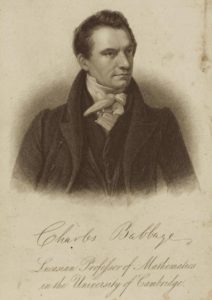
For flexibility, Babbage intended to use punched cards for input of programs and data and then print results to punched cards. The punched cards were to be strung together like in the looms. Intermediate results output on cards would be in the store (presumably this would mean that some cards might not be connected physically to others). The punched card concept was inspired by the Falcon-Jacquard’s loom. Babbage knew of Jacquard and even had a portrait of Jacquard woven on his loom using 24000 cards (see figure 12 here). A general description of the calculating machine of the early years is provided in his text: On the Mathematical Powers of the Calculating Engine (Babbage 1837, see Randell 1982), which we quote in the following. Babbage discussed at length his ideas with Ada Lovelace Byron (1815-1852) and she described many aspects of the use of the cards in appendices to her translation of the Italian Luigi Federico Menabrea’s article: Sketch of the Analytical Engine Invented by Charles Babbage (Menabrea 1842). In Menabrea’s words : “To take another point of view: the use of the cards offers a generality equal to that of algebraical formulæ... .”
Babbage described how he thought of using the cards, using the Jacquard “cylinder” (prism in Babbages text), relying on rods or levers that push through the holes in the cards. The cards were designed as program cards and variable cards and were of different size and with different number of holes (see figures 8 and 9).
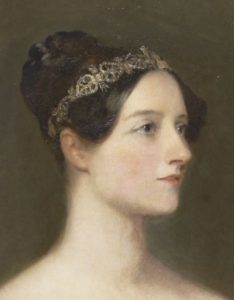
“Again if a card having as many holes as the prism has, or as there are levers opposite to it, is placed upon the advancing face of the prism no effect can be produced on the levers by this advance of the prism. But if a card having one hole less than the prism is placed on its face then when the prism advances the lever opposite that hole will be pushed and any order given for which that lever was appointed. Suppose after every order the levers to be replaced and let the prism be turned one quarter round then a new card will be presented to the levers and if one or more holes of this second card are stopped up a different order will be transmitted through the levers to the Reducing Apparatus and thence to the barrels. Thus by arranging a string of cards with properly prepared holes any series of orders however arbitrary and however extensive may be given through the intervention of these levers.”
To implement conditions, Babbage thought of using “peculiar“, “Combinatorial cards” inserted in between the program cards along with what he called “index” cards (these implemented what we would call jump/branch and loop control):
“One or more peculiar cards may be inserted among the operation cards of certain formulae. They are called Combinatorial Cards. The object of these Cards is:- “To govern the Repeating Apparatus of the Operation and of the Variable Cards and thus to direct at certain intervals the return of those Cards to given places and to direct the number and nature of the repetitions which are to be made by those cards. Whenever Combinatorial Cards are used other cards called index cards must occur amongst those of the formulae. The use of these cards is to compute the numbers which are to serve successively for the indices of the combinatorial cards. At what time the Combinatorial Cards shall act depends on the number of repetitions the last of those cards appointed. What orders each Combinatorial Card shall give depends on the nature of each individual Card.”
Concerning the repeating of instructions, Ada Lovelace remarks that (Appendix C, Manabrea 1842):
“The mode of application of the cards, as hitherto used in the art of weaving, was not found, however, to be sufficiently powerful for all the simplifications which it was desirable to attain in such varied and complicated processes as those required in order to fulfil the purposes of an Analytical Engine. A method was devised of what was technically designated backing the cards in certain groups according to certain laws. The object of this extension is to secure the possibility of bringing any particular card or set of cards into use any number of times successively in the solution of one problem.” …. and the mechanics of the process would be : “Those who understand the mechanism of this loom will perceive that the above improvement is easily effected in practice, by causing the prism over which the train of pattern-cards is suspended to revolve backwards instead of forwards, at pleasure, under the requisite circumstances; until, by so doing, any particular card, or set of cards, that has done duty once, and passed on in the ordinary regular succession, is brought back to the position it occupied just before it was used the preceding time. The prism then resumes its forward rotation, and thus brings the card or set of cards in question into play a second time. This process may obviously be repeated any number of times.”
The input, final and intermediate data would be on “Number cards”:
“The Number Cards have been introduced for the purpose of rendering the calculations absolutely unlimited by the too great number of variables and constants necessary for the solution of any problem …These number cards are for some purposes more convenient than figure wheels because the numbers upon a figure card are not obliterated by the act of giving them off. For by turning the string of figure cards back to any given one the number upon that card can be replaced in the Store as frequently as may be required and at any periods of time which the calculation may demand. On the other hand the numbers placed upon figure wheels are always obliterated in the act of giving them off. If it is necessary to retain on the Store any number which is to be given off to the Mill then it also must be given off through the rack to another store axis on whose figure wheels it must remain untill at a second operation it is reconveyed by rack back to its original place.”
Recently the archives of the Museum of Applied Arts and Science (MAAS, Australia), revealed the existence of a copy of the Acklin Apparatus description, which has a specimen of the punched paper roll proposed by Acklin to replace the punched cards as a means of reducing space and cost (figure 10). This document has some scribbled notes in Babbage’s handwriting, indicating that Babbage may have envisaged to use this medium. Punched tape did became one of the program and data input/output media in 20th century digital computers. Babbage’s engines have been reconstructed years later and may be found in Science and Computer History museums in several countries. The punched cards used in the Hollerith-IBM tabulators and computers described below, had the same size as opposed to the program and data cards of Babbage.
Herman Hollerith and USA Census.
Hollerith started work in Washington, as a statistician, in the United States Census Bureau from 1879 to 1882. He was confronted with the massive challenge faced by hundreds of people trying to analyse tens of million records from the 1880 US census. Done manually, this job would take years. Shaw Billings, Hollerith’s colleague apparently suggested to Hollerith that a machine using Bouchon type punched tape could be advantageously used to mechanise and speed up this process.
From 1882 Hollerith shifted to the Massachusestes Institute of Technology and pursued this idea. The concept was, that the presence or absence of a hole could be mechanically or electrically detected by a machine without human intervention. This first attempt was not very successful for the same reasons as for Bouchon, i.e. the tape was fragile and it was difficult to correct errors. Because of sequential access, it also turned out to be difficult and time consuming to extract specific information on people, an essential point for cross-referencing for the census.

Fatefully, while travelling in 1883, Hollerith observed (Patton 1993) that in American railways, non transferable tickets were delivered by entering passenger specific information by means of punching holes in preselected boxes at the edge: sex, size, hair color and age etc as shown on the example of the Union Pacific System ticket in the figure 12. This was a sort of “punched photograph” that enabled the conductor to detect fraudulent use.
This appears to have inspired Hollerith to create such “punched photographs” on separate person specific cards for the census. These were much easier to correct and especially to sort and classify. From 1884 Hollerith worked on an electro-mechanical system allowing to sort cards, which were prepared manually by operators. His invention was first used in 1886 in Baltimore health services for mortality statistics.
The punched card became the central part of a data extraction and classification system, for which he filed a patent on June 8, 1887. It was granted on January 8, 1889. Hollerith could not patent the punched card concept, because of the prior, publicly known, existence of Babbage’s engine.
A number of machines were rented to health services of the Ministry of Defense and Navy and Hollerith finally won the Census contract for 1890. His machines were presented at exhibitions in Paris and Berlin in 1889.
The first punch card systems.
The cards were originally designed with a 3″ × 5½” (cm) size with holes to be punched along three outer sides so a train conductor type punch could be used. They evolved to be the size of the then dollar bills (about 8x19cm), probably to avail of existing storage possibilities. Hollerith designed a manual pantograph punching system, with which holes could be made in any point of the card and not only on the side, as in the railway ticket. In practice his card started of with 240 usable positions (from 12 lines x 24 columns) as shown in the image from an 1895 Railway Gazette newspaper (figure 13).
The 1890 system was composed of three units: punch, tabulator and a filing/sorting machine (figure 14). An operator would start by transferring handwritten information from each census sheet to a Hollerith card by manually punching (figure 15) holes according to a grid pattern. The special Hollerith puncher was used as shown. Different positions on the card represented possible choices. For instance two positions corresponded to e.g. male and female. A hole was punched at the correct position.
The cards were then processed using an electrical machine that replaced manual accounting (figure 14). This was equipped with a plate with a matrix of needles mounted on springs, following the same grid pattern as the card (figure 14 right). Beneath the card was a matrix of tiny mercury reservoirs, each of which formed part of an array of separate electrical circuits. Whenever a hole was present, a needle passed through it and contacted one of a set of tiny reservoirs of mercury under the card closing one electrical circuit (figure 14), which could be connected to an electromagnetic counter. In figure 14, the counters are the circular clock like meters with two arms: one for units (up to 99) and the second one counted full revolutions of the units hand up to 9999. Thus all the information of interest on the card could be read simultaneously and independently. This system is quite similar to the early French ones and proposed by others later, except here information was processed electrically.
The tabulator had a panel for up to 40 counters (figure 14). Each counter could be connected to specific card positions, which required manual rewiring. In operation, cards were read sequentially and closure of the electrical circuits would increment the counters, allowing to count the number of times a circuit corresponding to a given hole or card position was activated. Thus for instance you could know how many men or women were present, or how many were married. Hollerith also designed a combinatorial relay system allowing to select a set of properties, e.g. male, married, white…etc.
The last part, was a filing system (figure 16): a set of closed drawers, whose lids were electromagnetically opened whenever a given circuit was closed. The corresponding card was then stored in that drawer. This allowed distributing cards according to any desired combination of properties or items on the card. In 1896 Hollerith produced the Integrating Tabulator, which could add numbers coded on punched cards. Around 1900 he added an automatic card-feed reader mechanism for the 1890 Census and in 1906 a new automatic feed tabulator appeared, with a control panel allowing to simplify the wiring of the tabulator, instead of doing it manually.
Hollerith gave a first description of this system in 1889: An Electric Tabulating System (1889), which was submitted to Columbia University as his doctoral thesis. His description did not mention the much older use of punched cards and it is not clear if he knew about it. His distinct major contribution here, was the development of a electrical data acquisition and the development of data processing.
The evolution of the punched card systems and birth of IBM.
The Hollerith tabulating system immediately became popular and his machines were even rented out to other countries, resulting in a spread of the ideas of mechanographic data processing. Hollerith’s first commercial venture was called the The Hollerith Electric Tabulating System, which was transformed into the The Tabulating Machine Company in 1896. In 1911 four corporations, including Hollerith’s, were amalgamated to form the Computing-Tabulating-Recording Company (CTR). Under the presidency of Thomas J. Watson, CTR was renamed International Business Machines Corporation (IBM) in 1924.
With time the punched card data processing systems: the tabulating machines, evolved to perform more complex tasks for companies for product management and accounting. A full system ended up by having as essential parts key punches, verifiers to cross-check for errors; sorters and collators for sorting, merging, and comparing groups of cards; and accounting and printing units which could perform arithmetical or other calculations before outputting required results to the printer.
By the the 1920s the machines were equipped with printers and had the ability to perform subtractions. IBM was not the only company doing this development. Multiplying tabulators were developed at the end of the 1920’s and IBM bought the Austrian inventor Gustav Tauschek‘s multiplyng punch card machine, which was to be produced by a German Rheinmetal subsidiary (Helfert et al 2007).
Punched Card Formats.
In order to increase the amount of data on cards, Hollerith had introduced a 45 column card (figure 17a). This was followed by the famous IBM 80 column card (figure 17b) by the end of the 1920s. The round holes gave way to rectangular ones to save space, though in later years you can still find some example of cards with round holes. The 80 column computer terminals and matrix printers inherited this format.
Initially, as mentioned above, the different Hollerith cards were organised for yes/no options, as in multiple choice forms today. To make cards usable in a more general way, they were organised into zones for numeric, alphanumeric and special characters as in the example in figure 17a.
Amongst the variety of punched cards, it is perhaps worth mentioning the distinctive small “96” column IBM card with tiny 1 mm holes (figure 17c). Some other computer companies (Remington Rand, Powers, UNIVAC) used 90 column cards. A special type of aperture card was produced to include microfilm data (figure 18c). In the 1930s a test scoring card was developed and evolved into the electrographic mark sense card (figure 18b) where certain designated regions on the card were marked with a pencil and later holes were punched: a feature useful for a person in the field far from office equipment. The diagonal cut on the top left-hand corner was used to detect misoriented cards in a stack.
The edge punched cards.
In 1896 by Henry P. Stamford invented a different type of cards (US patent 564,117), which were meant to be sorted manually. Variants were proposed by others and they were produced by companies like McBee, Mecanalyse, Indeck, Zatocards etc. The advantage was that there was no need for any special machinery. The cards had generally one or two rows of holes punched around the four edges and in some cases within the body of the card. They came in a variety of sizes: frequently quite large: in the A4/A5 paper format size ((A4: 210 × 297 mm or 8.27” × 11.69”), like the ones in figure 19. The large amount of central blank space allowed recording various user information explicitly. Cards with holes around edges were sorted with rods or needles. The ones with holes in the central regions were sorted by other techniques: optical, electrical etc.
The holes around the edges corresponded to some predefined classification fields, useful in sorting and were identified with either some text label or index numbers. The idea was that the edge of the card at the hole could be cut out, or “notched”. Sorting was done manually by inserting needles into a stack of cards, which allowed to easily pick out unwanted cards without notches, leaving behind the desired notched cards, as they “fell off” the needle. One of the main advantages was the possibility of easy multicritereon sorting, using more than one needle. Successive sorting could be done for refinement. These cards were well adapted for the so called facetted classification method as proposed originally for libraries in India by S.R. Ranganathan (see e.g. Foskett 1959). Some images of the cards shown here come from an old archive of the US National Endwoment for Humanities organisation, which have now been digitised. One can see groups of main categories, some chosen sorting criteria (notches) and some “repairs” done on some of the cards.
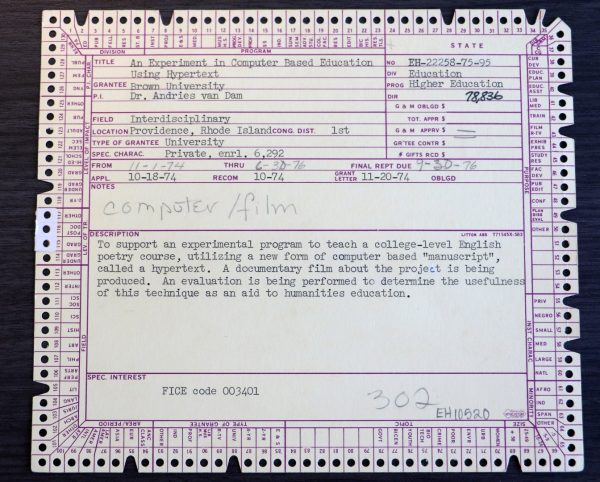

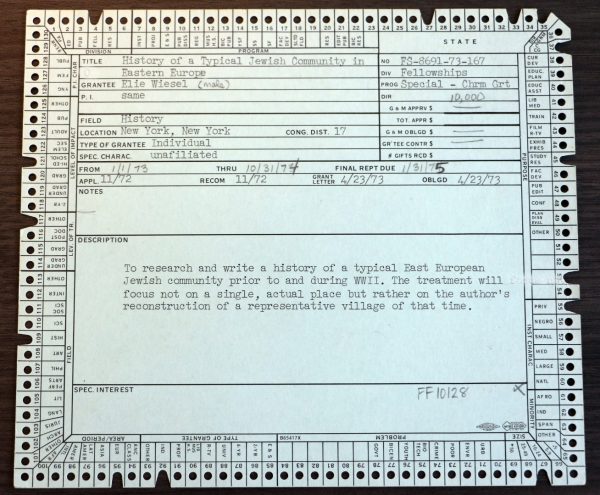
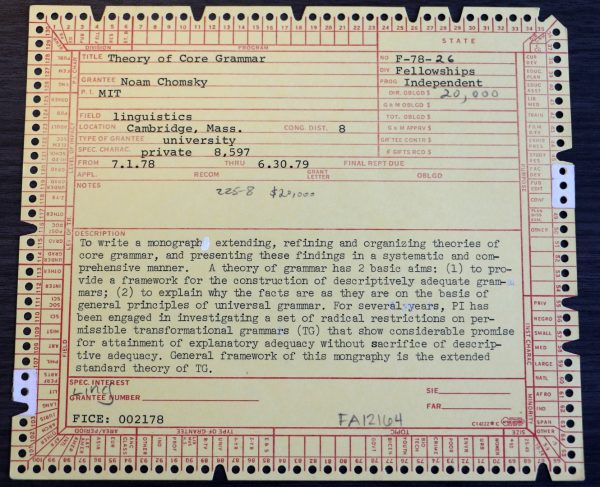
Figure 19. Large edge punched “McBee cards” for early National Endowment for the Humanities Grants to persons like Marlon Brando, Noam Chomsky, Elie Wiesel and Andries van Dam. Courtesy: Brett Bobley, National Endowment for the Humanities (USA). Photos by Chris Flynn / National Endowment for the Humanities.
20th Century use.
In the first half of the 20th century, punched cards were widely used in various government and social services, libraries, highway tolls, payrolls, banking and other businesses (figure 24). IBM even had an advertisement claiming that with punched cards you could control everything everywhere (figure 20a). Big brother was watching! Back in 1934, even more ominously the IBM subsidiary Dehomag (Black 2001), that produced tabulating equipment, proclaimed that with Hollerith punched cards you could oversee everything (Ubersiht mit Hollerith Lochkarten) figure 20b. The company’s equipment was indeed very much present in the organisation and certain “Solutions” of the third Reich.
With the advent of electronic digital computers in the 1950s and up till the 1970s, punched cards became a familiar object for many people in business administration and science. Their use decreased thereafter, but even today you can still find punched cards in some applications (not necessarily of the formats seen here).
Massive amounts of cards were thus generated and had to be stored and processed. As had been noted many years earlier by Menabrea: “Perhaps the immense number of cards required for the solution of any rather complicated problem may appear to be an obstacle; but this does not seem to be the case. There is no limit to the number of cards that can be used. Certain stuffs require for their fabrication not less than twenty thousand cards, and we may unquestionably far exceed even this quantity.” A nice illustration of the size of a punched card “deck” for a program is provided in figure 21.
How did you go about programming with punched cards?
Today you sit at your laptop/desktop, wtite a program in say the Fortran language, compile it (translate it to machine understandable language) and then if the commpiler does not indicate errors,” run” it. What did you do, if you were a programmer in the golden era of punched cards?
Some recollections from the early 1970s.
- You would normally first write your program on a piece of paper, carefully cross check it and take it to a computing centre, which was probably not next door.
- Possibly you would give your program to someone: an operator who would transfer it to punched cards. Perhaps you would do this yourself (figure 21c). You would end up with a deck, or pile of of punched cards. One line of the program code was one punched card.
- How did you know what was on a card full of holes? If you had foresight, you would have asked to have the program line printed on the punched cards. This usually appeared near the top edge of the card.
- You would then take it to the room, where the (big) computer was located and give them to the person in charge of getting your programs to run.
- You would then wait some time, depending upon the number of people before you.
- This was just the beginning, as the program had to be compiled! It is quite possible that you missed a syntax error and then you would get back your punched cards and a printed paper with an error message from the compiler: say “missing “;” in line…”.
- You would then correct the program and replace all or some of the punched cards.
- Then go back to the computer. If the compiler was happy, you would get a new deck of punched cards with the executable program in the language of the computer.
- Then finally you would get your program to be run and get the printed output.
- Did you get what you expected? No? … Well, then you maybe needed (as you would today) to debug your program: find errors.
- Then you started all over again, and again, if you were optimising the program to run faster.
- What happened if you dropped your big deck of punched cards? One rough way of handling this, was to draw a line or write something across the side of the deck as in figure 22b, so you could put them back together. This was a crude way of doing it, though immediately apparent if you had not added or modified the original deck. A cleaner way, used the columns 73 to 80 on punched cards (figure 17b), which were not employed for the programs. The program deck could then be sorted using a special sorter.
Punched tape.
Punched tape (figure 24c) was a common medium for teleprinters developed starting from the 19th century, by people like A. Bain, S. Morse, D.Hughes and others. Most teleprinters used a 5-bit Baudot-Murray, International Telegraph Alphabet derived from the Baudot code (1870). In later years teleprinters like the popular Teletype model 33 used a 7-bit ASCII code (with an eighth parity bit).
A number of early computers like the World War II British Colossus (1943-44) or the Harvard Mark I (1944), used punched tape to read and output data (figure 23). In later years, small easily accessible computers, like the PDPs and small microprocessor based computers, used punched tapes with teletypes, integrating keyboards and printers (ASR 33, teletype, figure 24d). This was a much “lighter” system than the punched card machinery. Punched tape was stored rolled up or folded.
Punched cards in access control.
In 1975, Norwegian engineer Tor Sørnes invented a mechanical hotel key card locking system, that became immediately extremely popular (see details in US patent here). It consisted in two plastic cards, with a complementary sets of holes made in a 32 position matrix. One card is placed in the lock and the complementary card is given as key to a hotel guest (see sample from New Lock Systems in Fig.25). When the cards are inserted correctly, spring loaded rods which correspond to the 32 positions allow opening of the door. The 32 holes in the key gave 4.2 billion combinations. This lock system known as VingCard was patented in 29 countries. An alternative to this mechanical system is implemented using an optical readout.
21st Century and nano-punched media.
You might still find some rare uses of punched cards today (besides their use for embroidery machines). Punched cards were still used in e.g. the US 2000 presidential and till 2014 in some US state elections. In 2012 there was a report of a company in the US (Sprinkler, Conroe, Texas) that still used an old IBM 402 computer and punched cards. One area where punched cards continue to be used is in access control systems, such as hotel door card keys mentioned previously. These are still being manufactured, although magnetic readout and RFID card-operated locks are popular options.
The appearance of nanotechnology methods in the late 20th century has allowed emergence of methods of manipulating materials at the scale of a nanometer: one billionth of a meter (see e.g. Meena 2014). In 2002, researchers at IBM laboratories proposed a method of creating ordered patterns of nanometric indents in a polymer using an atomic force microscope. The microscope uses a hot tip fixed on a cantilever (Fig. 26; Gottsman 2010) that softens the polymer and momentarily sinks into it, generating an indentation. For reading, the tip is operated at room temperature. To over-write unwanted data, a set of slightly offset pits are made so that they fill in the old pits.
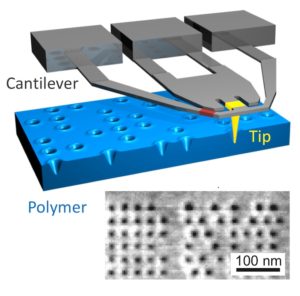
In the 2002 IBM experiment, an atomic force microscope with a 3 mm by 3 mm array of 1,024 (32 x32) tiny tips was used, each of which could be operated individually. This achieved an areal density of 200 gigabits (billion bits, Gb) per square inch, corresponding to a potential capacity of about 0.5 gigabytes (billion bytes, GB) in a 3 square mm area. This multi-tipped device inspired the name millipede. Experiments have shown (Gottsman 2010) that even at high (85°C) temperature the pits were stable and did not disappear over a very long period of time.
Will this one day become a usable technology?
References.
- Archives ANSSSR. 1961. From the history of computing devices, based on materials from the Archive of the USSR Academy of Sciences in Russian. Iz istorii vychislitel’nykh ustroistv (po materialam Arkhiva AN SSSR) (Из истории вычислительных устройств, по материалам Архива АН СССР). In: Istoriko- matematicheskiye issledovaniya, vyp. XIV, Nauka, Moscow, 557-564, 579-580 (1961).
- Baehne, George W. (IBM), Practical Applications of the Punched Card Method in Colleges and Universities, Columbia University Press (1935); hardbound, 442 pages, 257 figures. https://archive.org/details/PracticalApplicationsOfThePunchedCardMethodInCollegesAndUniversities
- Black Edwin, 2001. IBM and the Holocaust: The Strategic Alliance between Nazi Germany and America’s Most Powerful Corporation. New York: Crown Publishers, 2001. ISBN-13 : 978-0914153276
- Casey Robert S. and Perry James W. 1958. Punched Cards: Their Applications to Science and Industry. Pub.- Van Nostrand Reinhold. ISBN-13: 978-0442152130
- Foskett D.J. 1959. The Construction of a Faceted Classification for a Special Subject. International Conference on Scientific Information, 1958, p.867.Washington, USA.
- Gotsmann Bernd, Knoll AW, Pratt R, Frommer J, Hedrick JL, Duerig U. 2010. Designing polymers to enable nanoscale thermomechanical data storage. Adv Funct Mater 2010, 20, 1276–1284.
- Heide Lars. 2009. Punched-Card Systems and the Early Information Explosion, 1880–1945. The Johns Hopkins University Press. ISBN: 9780801891434
- Helfert Martin, Mazuran Petra, Wintersteiger Christoph M. 2007. Gustav Tauschek und seine Maschinen. Volume 10 of Geschichte der Naturwissenschaften und der Technik. Ed.: Franz Pichler, Johannes Kepler University of Linz, Austria. Verlag Rudolf Trauner, Austria, February 2007. ISBN 978-3-85499-062-8
- Korsakov, Semyon N. 1832. Aperçu d’un procédé nouveau d’investigation au moyen de machines à comparer les idées. St. Petersburg: 1832.
- Lubar Steven. Do not Fold, Spindle or Mutilate: A cultural history of the punch card. archive.org.
- Meena Jagan Singh , Sze Simon Min, Umesh Chand Umesh and Tseng Tseung-Yuen, 2014. Overview of emerging nonvolatile memory technologies. Nanoscale Research Letters 9, 526
- Menabrea Luigi Federico, 1842-43. “Notions sur la machine analytique de Charles Babbage,” Bibliothèque Universelle de Genève 82 (October 1842).The trans- lated article with Lovelace’s notes was published as “Sketch of the Analytical Engine Invented by Charles Babbage, Esq. By L. F. Menabrea, of Turin, Officer of the Military Engineers.With Notes by the Translator,” Scientific Memoirs 3 (1843), pp. 666–731
- Patton, Phil. 1993. Made in USA: The Secret Histories of the Things that Made America. Penguin books. ISBN-10: 0140175881
- Randell Brian (ed). 1982. The Origins of Digital Computers, Selected Papers, 3rd ed. Springer-Verlag. ISBN 0-387-11319-3. Chapter 3, Tabulating Machines, has excerpts of Hollerith’s 1889 An Electric Tabulating System and Couffignal’s 1933 Calculating Machines: Their Principles and Evolution.
- Povarov, Gellius N. 2001. Semen Nikolayevich Korsakov. Machines for the Comparison of Philosophical Ideas. In: Computing in Russia. The History of Computer Devices and Information Technology revealed. G. Trogemann, A. Y. Nitussov, W. Ernst (Eds.), 47-49. VIEWEG, Wiesbaden (2001)
- Shilov Valery and Silantiev Sergey. 2016. ‘Machines à Comparer les Idées’ of Semen Korsakov: First Step Towards AI. IFIP International Conference on the History of Computing (HC), May 2016, Brooklyn, NY, United States. pp.71-86, 10.1007/978-3-319-49463-0_5 . hal-01620143

